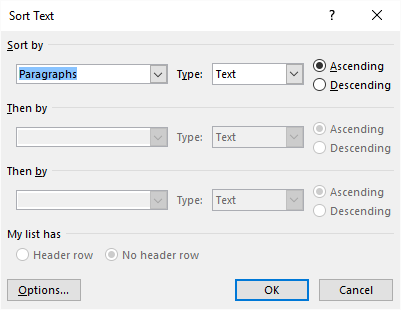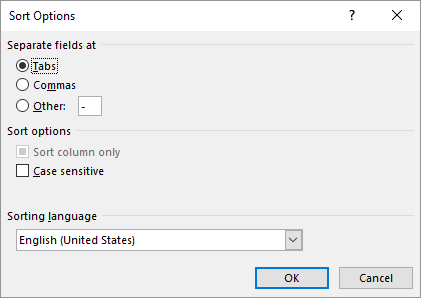Please Note: This article is written for users of the following Microsoft Word versions: 2007, 2010, 2013, 2016, 2019, 2021, and Word in Microsoft 365. If you are using an earlier version (Word 2003 or earlier), this tip may not work for you. For a version of this tip written specifically for earlier versions of Word, click here: Controlling Sorting Order.
Written by Allen Wyatt (last updated September 23, 2023)
This tip applies to Word 2007, 2010, 2013, 2016, 2019, 2021, and Word in Microsoft 365
If you have used Word for more than a week, you probably already know how to sort information in your document. You can use sorting to arrange a list in either ascending or descending order. Ascending order for the English language is from 0 to 9, A to Z; descending order is the reverse. The sorting order for other languages will be different. To specify the sorting order you simply choose the Ascending or Descending radio buttons in the Sort dialog box.
You can also affect sort order by indicating whether Word should pay attention to the case of the text in your selection. If a sort is case sensitive, then items are sorted A to Z and then a to z for ascending sorts. If a sort does not pay attention to case, then uppercase and lowercase letters are treated the same.
To specify whether Word should pay attention to case, follow these steps:

Figure 1. The Sort Text dialog box.

Figure 2. The Sort Options dialog box.
WordTips is your source for cost-effective Microsoft Word training. (Microsoft Word is the most popular word processing software in the world.) This tip (11465) applies to Microsoft Word 2007, 2010, 2013, 2016, 2019, 2021, and Word in Microsoft 365. You can find a version of this tip for the older menu interface of Word here: Controlling Sorting Order.

Create Custom Apps with VBA! Discover how to extend the capabilities of Office 365 applications with VBA programming. Written in clear terms and understandable language, the book includes systematic tutorials and contains both intermediate and advanced content for experienced VB developers. Designed to be comprehensive, the book addresses not just one Office application, but the entire Office suite. Check out Mastering VBA for Microsoft Office 365 today!
When sorting information, Word follows some pretty strict rules. If you want to modify how those rules are applied, you ...
Discover MoreGot a document that contains a bunch of addresses? If you want to sort the addresses, then you are in for a surprise ...
Discover MoreSome people like to format simple tables using tabs instead of using Word's table editor. When it comes time to sort such ...
Discover MoreFREE SERVICE: Get tips like this every week in WordTips, a free productivity newsletter. Enter your address and click "Subscribe."
There are currently no comments for this tip. (Be the first to leave your comment—just use the simple form above!)
Got a version of Word that uses the ribbon interface (Word 2007 or later)? This site is for you! If you use an earlier version of Word, visit our WordTips site focusing on the menu interface.
Visit the WordTips channel on YouTube
FREE SERVICE: Get tips like this every week in WordTips, a free productivity newsletter. Enter your address and click "Subscribe."
Copyright © 2025 Sharon Parq Associates, Inc.
Comments